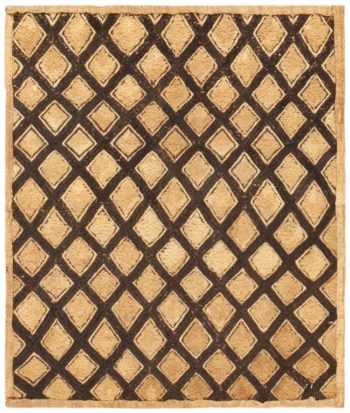African Kuba Textiles
Explore Style: Shop Antique African Kuba Textiles
View our current selection of antique African Kuban textiles below:
Antique African Silk Loincloth 70849
Size: 1 ft 10 in x 15 ft (0.56 m x 4.57 m)Antique African Kuban Mat 46135
$900.00Size: 1 ft 6 in x 1 ft 9 in (0.46 m x 0.53 m)
Learn More About Antique African Kuban texiles
Antique African Kuban Textiles – An art form unique to the Democratic Republic of the Congo (formally called Zaire) Kuba textiles – sometimes referred to broadly as “Kuba cloth” – represent a distinctly tribal development in the world of fine weaving. These beautiful and distinct compositions are valued for their complexity and immediately recognizable decoration, as well as for the powerful impression of genuine tribal authenticity that they convey. Generally, Kuba textiles are woven with palm leaf fibers, and typically feature distinct geometric designs, especially complex, interrupted lines and shapes.
It is Kuba women who are responsible for the weaving of textiles – the manufacture of ceremonial skirts, headdresses, baskets, and any other weaving work has traditionally fallen to them. African Kuba textiles occupy a unique place in the world of antique rugs, and their distinct aesthetic style has long inspired spirited discussions about the merit of eccentric geometric line work in textiles. In the wake of the influence of the mid-century artists who celebrated these aesthetic traits more so than their predecessors, Kuba textiles and similar works are appreciated by Westerners more than ever before. Today, these unique works are valued for their cultural authenticity, and the inherently challenging nature of their exciting, geometric designs.
What are African Kuba Textiles?
African Kuba textiles, also known as Kuba cloths or Kuba raffia textiles, are a type of traditional textile art created by the Kuba people of Central Africa, primarily from the Democratic Republic of Congo. These textiles are renowned for their intricate and complex designs, which are made by weaving together thin strips of raffia palm leaves.
Here are some key characteristics and features of African Kuba textiles:
- Raffia Palm Fiber: The primary material used in Kuba textiles is raffia palm fiber. The Kuba people carefully harvest, prepare, and dye the raffia palm leaves to create various colors and textures.
- Handwoven Designs: Kuba textiles are handwoven, typically by Kuba women, using a variety of weaving techniques. The most common technique is known as “cut-pile” or “pile-weave,” where the weaver creates raised patterns on the textile’s surface by selectively cutting and leaving loops of the raffia strips.
- Geometric Patterns: Kuba textiles are characterized by their intricate geometric patterns, which often include squares, diamonds, and abstract designs. These patterns are not only decorative but also convey symbolic meanings and cultural stories.
- Multiple Panels: Kuba cloths are often composed of multiple panels sewn together, creating larger pieces that can be used as clothing, wall hangings, or ceremonial items. The joining of panels allows for even more complex and varied designs.
- Natural Dyes: The Kuba people use natural dyes made from various plant sources to color the raffia fibers. These dyes produce a range of earthy and vibrant colors.
- Cultural Significance: Kuba textiles have deep cultural and social significance among the Kuba people. They are used for various purposes, including clothing, home decor, and ceremonial objects. Different patterns and designs may represent specific clans, events, or individuals within the community.
- Collectible Art: Kuba textiles are highly regarded as collectible art and are sought after by collectors and art enthusiasts around the world. They have been exhibited in museums and galleries, showcasing the intricate craftsmanship and cultural richness of the Kuba people.
It’s important to note that Kuba textiles vary in style, design, and complexity, as different Kuba subgroups and regions have their own distinct weaving traditions and patterns. These textiles are not only aesthetically captivating but also serve as important cultural artifacts that preserve the traditions and history of the Kuba people.


